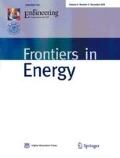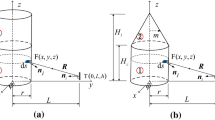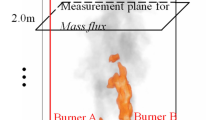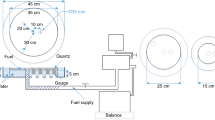Abstract
The interaction of multiple fires may lead to a higher flame height and more intense radiation flux than a single fire, which increases the possibility of flame spread and risks to the surroundings. Experiments were conducted using three burners with identical heat release rates (HRRs) and propane as the fuel at various spacings. The results show that flames change from non-merging to merging as the spacing decreases, which result in a complex evolution of flame height and merging point height. To facilitate the analysis, a novel merging criterion based on the dimensionless spacing S/zc was proposed. For non-merging flames (S/zc > 0.368), the flame height is almost identical to a single fire; for merging flames (S/zc ⩽ 0.368), based on the relationship between thermal buoyancy B and thrust P (the pressure difference between the inside and outside of the flame), a quantitative analysis of the flame height, merging point height, and air entrainment was formed, and the calculated merging flame heights show a good agreement with the measured experimental values. Moreover, the multi-point source model was further improved, and radiation fraction of propane was calculated. The data obtained in this study would play an important role in calculating the external radiation of propane fire.
Similar content being viewed by others
References
Ji J, Wan H X, Gao Z H, et al. Experimental study on flame merging behaviors from two pool fires along the longitudinal centerline of model tunnel with natural ventilation. Combustion and Flame, 2016, 173: 307–318
Fan C G, Ji J, Li Y Z, et al. Experimental study of sidewall effect on flame characteristics of heptane pool fires with different aspect ratios and orientations in a channel. Proceedings of the Combustion Institute, 2017, 36(2): 3121–3129
He K, Cheng X, Yao Y, et al. Characteristics of multiple pool fires in a tunnel with natural ventilation. Journal of Hazardous Materials, 2019, 369: 261–267
Shi C, Liu W, Hong W, et al. A modified thermal radiation model with multiple factors for investigating temperature rise around pool fire. Journal of Hazardous Materials, 2019, 379(5): 120801
Liu N A, Zhang S, Luo X, et al. Interaction of two parallel rectangular fires. Proceedings of the Combustion Institute, 2019, 37(3): 3833–3841
Wan H X, Ji J, Li K, et al. Effect of air entrainment on the height of buoyant turbulent diffusion flames for two fires in open space. Proceedings of the Combustion Institute, 2017, 36(2): 3003–3010
Putnam A, Speich C. A model study of the interaction of multiple turbulent diffusion flames. Symposium (International) on Combustion, 1963, 9(1): 867–877
Thomas P, Baldwin R, Heselden A. Buoyant diffusion flames: some measurements of air entrainment, heat transfer, and flame merging. Symposium (International) on Combustion, 1965, 10(1): 983–996
Sugawa O, Takahashi W. Flame height behavior from multi-fire sources. Fire and Materials, 1993, 17(3): 111–117
Wan H X, Gao Z H, Ji J, et al. Experimental study on merging behaviors of two identical buoyant diffusion flames under an unconfined ceiling with varying heights. Proceedings of the Combustion Institute, 2019, 37(3): 3899–3907
Wan H X, Gao Z H, Ji J, et al. Effects of pool size and spacing on burning rate and flame height of two square heptane pool fires. Journal of Hazardous Materials, 2019, 369: 116–124
Delichatsios M A. A correlation for the flame height in “group” fires. Fire Science & Technology, 2007, 26(1): 1–8
Fukuda Y, Kamikawa D, Hasemi Y, et al. Flame characteristics of group fires. Fire Science & Technology, 2004, 23(2): 164–169
Weng W, Kamikawa D, Hasemi Y. Experimental study on merged flame characteristics from multifire sources with wood cribs. Proceedings of the Combustion Institute, 2015, 35(3): 2597–2606
Wan H X, Gao Z H, Ji J, et al. Predicting heat fluxes received by horizontal targets from two buoyant turbulent diffusion flames of propane burning in still air. Combustion and Flame, 2018, 190: 260–269
Gong C Z, Ding L, Wan H X, et al. Spatial temperature distribution of rectangular n-heptane pool fires with different aspect ratios and heat fluxes received by adjacent horizontal targets. Fire Safety Journal, 2020, 112: 102959
Shokri M, Beyler C. Radiation from large pool fires. Journal of Fire Protection Engineering, 1989, 1(4): 141–149
Liu Q, Liu N A, Huang X. Radiative heat transfer from multiple discrete fires. Journal of Fire Sciences, 2017, 35(6): 535–546
Markstein G. Radiative properties of plastics fires. Symposium (International) on Combustion, 1979, 17(1): 1053–1062
Bennett G. The SFPE handbook of fire protection engineering: By P. J. DiNenno, C. L. Beyler, R. L. P. Custer, W. D. Walton and J. M. Watts, National Fire Protection Association, Quincy, MA and Society of Fire Prot, Elsevier, 1990
Mudan K S. Thermal radiation hazards from hydrocarbon pool fires. Progress in Energy and Combustion Science, 1984, 10(1): 59–80
May W, Mcqueen W. Radiation from large liquefied natural gas fires. Combustion Science and Technology, 1973, 7(2): 51–56
Yan W G, Wang C J, Guo J. One extended OTSU flame image recognition method using RGBL and stripe segmentation. Applied Mechanics and Materials, 2012, 121–126: 2141–2145
Otsu N. A threshold selection method from gray-level histograms. IEEE Transactions on Systems, Man, and Cybernetics, 1979, 9(1): 62–66
James G Q. Fundamentals of Fire Phenomena. New York: Springer, 2005
Gao Z H, Ji J, Wan H X, Li K, Sun J. An investigation of the detailed flame shape and flame length under the ceiling of a channel. Proceedings of the Combustion Institute, 2015, 35(3): 2657–2664
Dupuy J, Marechal J, Morvan D. Fires from a cylindrical forest fuel burner: combustion dynamics and flame properties. Combustion and Flame, 2003, 135(1–2): 65–76
Shintani Y, Nagaoka T, Deguchi Y, Ido K, Harada K. Simple method to predict downward heat flux from flame to floor. Fire Science & Technology, 2014, 33(1): 17–34
Lowesmith B J, Hankinson G, Acton M, Chamberlain G. An overview of the nature of hydrocarbon jet fire hazards in the oil and gas industry and a simplified approach to assessing the hazards. Process Safety and Environmental Protection, 2007, 85(3): 207–220
Markstein G H. Radiative energy transfer from turbulent diffusion flames. Combustion and Flame, 1976, 27: 51–63
Hankinson G, Lowesmith B J. A consideration of methods of determining the radiative characteristics of jet fires. Combustion and Flame, 2012, 159(3): 1165–1177
Souil J, Joulain P, Gengembre E. Experimental and theoretical study of thermal radiation from turbulent diffusion flames to vertical target surfaces. Combustion Science and Technology, 1984, 41(1–2): 69–81
Hurley M J, Gottuk D T, Hall J R, et al. SFPE Handbook of Fire Protection Engineering. New York: Springer, 2015
Acknowledgements
This work was supported by the National Natural Science Foundation of China (Grant Nos. 52036009 and 51722605).
Author information
Authors and Affiliations
Corresponding author
Rights and permissions
About this article
Cite this article
Ji, J., Duan, J. & Wan, H. A method of determining flame radiation fraction induced by interaction burning of tri-symmetric propane fires in open space based on weighted multi-point source model. Front. Energy 16, 1017–1026 (2022). https://doi.org/10.1007/s11708-020-0716-x
Received:
Accepted:
Published:
Issue Date:
DOI: https://doi.org/10.1007/s11708-020-0716-x




